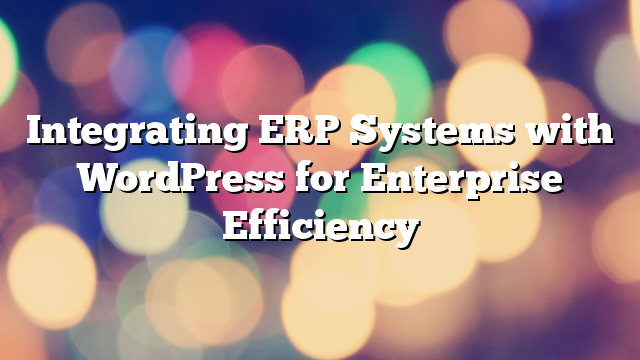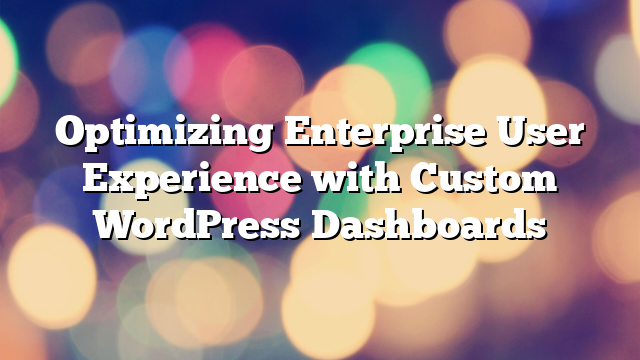WordPress Multisite for Enterprise Content Management
16.10.2024

Managing multiple websites or subdomains under one umbrella can be a complex challenge for enterprises. WordPress Multisite provides a powerful solution by enabling businesses to control multiple websites from a single WordPress installation. In this article, we’ll explore how WordPress Multisite can streamline enterprise content management and provide scalability across diverse projects.
What is WordPress Multisite?
WordPress Multisite is a feature that allows you to create a network of websites within a single WordPress installation. With this setup, each website within the network can operate independently while sharing the same core codebase, themes, and plugins. This is particularly useful for enterprises that need to manage multiple websites, brands, or regional sites under a unified system.
Why Enterprises Should Use WordPress Multisite
Enterprises often have multiple websites with varying requirements—whether it’s different brands, regional branches, or divisions with unique content strategies. WordPress Multisite provides several advantages that make it ideal for managing complex, large-scale content ecosystems:
- Centralized Management: Multisite allows administrators to manage all websites from a single dashboard, reducing the complexity of handling updates, user roles, and security measures across multiple sites.
- Cost Efficiency: Rather than maintaining separate WordPress installations for each website, Multisite enables enterprises to manage them all under one installation, saving on hosting and maintenance costs.
- Scalability: Multisite is built to scale, allowing enterprises to add new websites easily without significant overhead. This is particularly beneficial for businesses expanding into new markets or launching new initiatives.
- Shared Resources: Plugins, themes, and other resources can be shared across the entire network, ensuring consistency and simplifying the deployment of updates and new features.
Use Cases for WordPress Multisite in Enterprises
WordPress Multisite is ideal for several enterprise-level use cases:
1. Managing Multiple Brands or Divisions
Large corporations often manage multiple brands, each with its own website. With WordPress Multisite, each brand can have its own independent website while still being managed from a central location. This ensures consistency in user experience and simplifies content governance across the entire organization.
2. Regional Websites for Global Enterprises
For businesses operating in multiple regions, WordPress Multisite allows the creation of localized websites tailored to specific markets. Each region can manage its content, while the global team retains control over the core brand elements and functionality.
3. Universities and Educational Institutions
Many universities use WordPress Multisite to manage different departments, research groups, or student projects. Each group can maintain its own website while the university’s IT department manages the overall infrastructure.
How to Set Up WordPress Multisite for Your Enterprise
Setting up WordPress Multisite for your enterprise involves a few key steps. Here’s an overview of the process:
- Activate Multisite: To enable Multisite, you’ll need to modify your WordPress configuration file (wp-config.php) and add a line of code that activates the feature.
- Choose Between Subdomains or Subdirectories: You can configure your Multisite network to create new sites either as subdomains (e.g., site1.yourcompany.com) or as subdirectories (e.g., yourcompany.com/site1). This decision will depend on your specific requirements.
- Network Setup: Once Multisite is activated, you can configure the network settings and create your first set of sites. The WordPress dashboard will gain a “Network Admin” section, where you can manage all the sites under your network.
- Configure Themes and Plugins: Administrators can choose which themes and plugins are available across the network or assign specific themes to individual sites. This allows enterprises to maintain a unified brand identity while still providing customization options for each site.
Managing Users in WordPress Multisite
One of the standout features of WordPress Multisite is its ability to manage users across multiple sites. Enterprises can assign different user roles with varying levels of access, ensuring that each team has the appropriate permissions for their responsibilities.
Key user management features include:
- Network Admin: The Network Admin oversees the entire Multisite network and has access to all settings and configurations. This role is typically reserved for IT administrators or senior web managers.
- Site Admins: Each site in the network can have its own site administrator. Site admins have full control over their individual website but do not have access to the other sites in the network.
- User Roles: Standard WordPress user roles—such as Editors, Authors, and Contributors—can be assigned to team members on a per-site basis, providing flexibility in managing content across the network.
Best Practices for Enterprise WordPress Multisite
To get the most out of WordPress Multisite, enterprises should follow these best practices:
- Standardize Themes and Plugins: To maintain consistency across multiple websites, use a limited set of approved themes and plugins that align with your enterprise’s branding and performance standards.
- Regular Backups: Given the complexity of a Multisite network, regular backups are essential. Ensure that both the database and the file system are backed up frequently to avoid data loss.
- Performance Monitoring: As your network grows, monitoring performance becomes critical. Use tools like New Relic or Lighthouse to keep track of site performance and address issues before they impact user experience.
- Security Best Practices: Multisite networks require robust security measures, such as enforcing strong passwords, limiting login attempts, and using SSL across all sites.
Conclusion
WordPress Multisite is an excellent solution for enterprises that need to manage multiple websites or subdomains from a central platform. By leveraging Multisite, businesses can streamline content management, ensure consistency across brands, and scale their digital presence efficiently. Whether managing regional sites or multiple brands, Multisite offers the flexibility and control that enterprises need to stay competitive.
If you’re ready to explore WordPress Multisite for your enterprise, contact the experts at AllWebDev for professional assistance.



